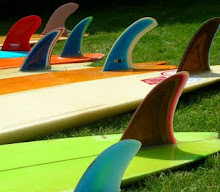
 You may have seen this 6ft Aqua-tek on ebay recently which didn't meet its hefty reserve, I don't think the seller really wanted to part with it and I don't blame him ! It was made by Bill Bailey in the mid 80s , the whole process of making and finishing the board done by one man on his farm and its a real work of art. Going against the grain of other UK boards of the time it has a singlefin , looks like old Bilbo stock, and rounded square tail with hips. Bill was a man who did his own thing, and back in the early 60s had been the first shaper of a modern board in the UK.
You may have seen this 6ft Aqua-tek on ebay recently which didn't meet its hefty reserve, I don't think the seller really wanted to part with it and I don't blame him ! It was made by Bill Bailey in the mid 80s , the whole process of making and finishing the board done by one man on his farm and its a real work of art. Going against the grain of other UK boards of the time it has a singlefin , looks like old Bilbo stock, and rounded square tail with hips. Bill was a man who did his own thing, and back in the early 60s had been the first shaper of a modern board in the UK. When he left Bilbo in 1970 it was hugely successful, but he said 'there were no more challenges as far as I was concerned. I thought the job was done .' Bilbo was probably one of the worlds biggest producers then, making 70 boards a week, employing 40 people and with four shops.
For the next seven years he went back to aircraft engineering and kept surfing. By 1980 he started thinking about making boards again and by around 1983 production was underway on his farm near Perranporth. Aqua-tek as a name reflects his interests in technical aspects of materials and design. He developed a board which was both a longboard and a windsurfer. He was also happy to shape a learner board which could be brought back in, glass ripped off and reshaped as the surfer got better and wanted more performance. Bill used his own blanks which were a bit thicker and with less rocker than most, as he said imported blanks were never designed for our waves. His boards were also a lot cheaper than other brands, he wanted surfing to be affordable.



















No comments:
Post a Comment